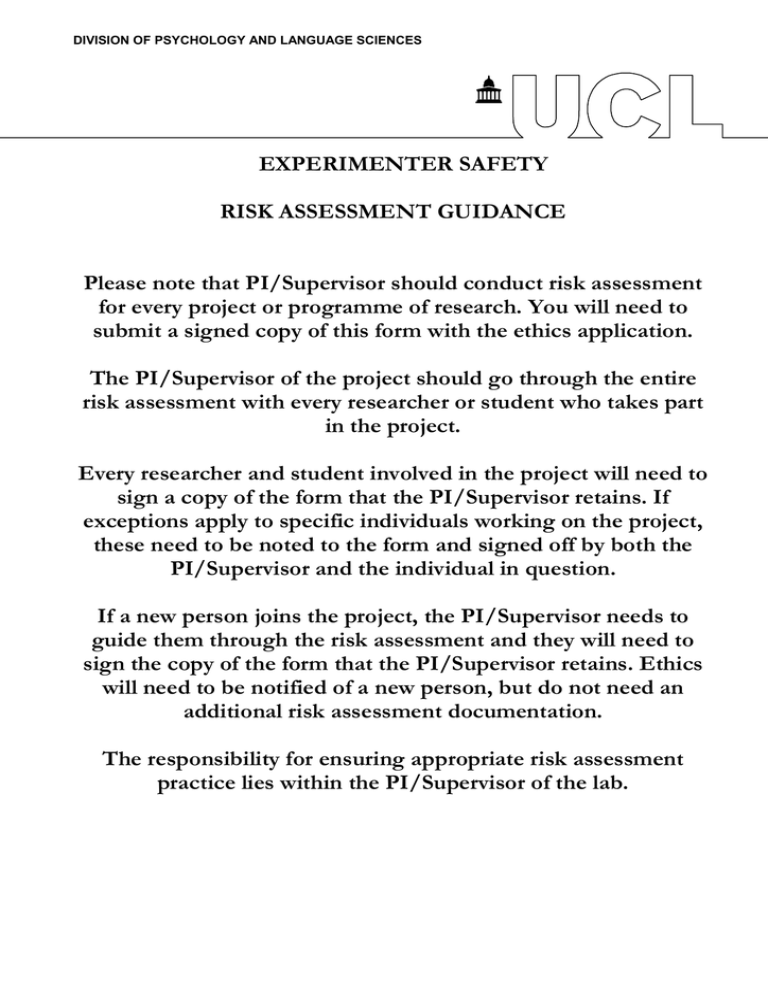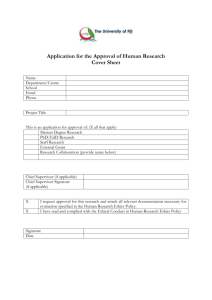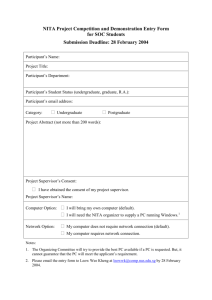EXPERIMENTER SAFETY RISK ASSESSMENT GUIDANCE
advertisement

DIVISION OF PSYCHOLOGY AND LANGUAGE SCIENCES EXPERIMENTER SAFETY RISK ASSESSMENT GUIDANCE Please note that PI/Supervisor should conduct risk assessment for every project or programme of research. You will need to submit a signed copy of this form with the ethics application. The PI/Supervisor of the project should go through the entire risk assessment with every researcher or student who takes part in the project. Every researcher and student involved in the project will need to sign a copy of the form that the PI/Supervisor retains. If exceptions apply to specific individuals working on the project, these need to be noted to the form and signed off by both the PI/Supervisor and the individual in question. If a new person joins the project, the PI/Supervisor needs to guide them through the risk assessment and they will need to sign the copy of the form that the PI/Supervisor retains. Ethics will need to be notified of a new person, but do not need an additional risk assessment documentation. The responsibility for ensuring appropriate risk assessment practice lies within the PI/Supervisor of the lab. DIVISION OF PSYCHOLOGY AND LANGUAGE SCIENCES EXPERIMENTER SAFETY RISK ASSESSMENT CHECKLIST CONTENTS Item Page No. 1. Planning Stages of Research Project………………………..……………....... 3 1.1 Safety Procedures……………………………………………………….. 3 1.2 Training and Individual Needs……….…………………...…………… 4 2. Off-Site Visits……...……………………………………………..................... 5 2.1 Preparation and Travelling ……...…………………………................. 5 2.2 Conduct During and Return from Visit.………………………………. 6 3. On-Site Appointments…………..……………..…………………………….... 7 3.1. Arranging Appointments.………...………………………………………. 7 3.2 Layout and Equipment…………….………………………………….….... 8 3.3 Meeting Participants……...………………………………………….….... 9 3.4 During and After Appointments………….….………………………….... 10 3.5 Personal Distress…………………………………………………………... 11 4. DECLARATION………………………………………………………………. 12 2 1. PLANNING STAGES OF RESEARCH PROJECT 1.1 ESSENTIAL SAFETY PROCEDURES Follow UCL safety procedures Follow Departmental safety guidelines where applicable Follow UCL procedures on Laboratory work, Biohazards etc. where applicable Contact Departmental Safety Officer (DSO) for guidelines on Departmental laboratory environments where applicable Inform Supervisor/Line Manager of any changes in an experimenter’s ability to undertake tasks, e.g. illness or pregnancy, so that risk assessments can be reviewed. Report any accidents/incidents that cause injury or damage to property or any dangerous occurrences to their Supervisor/Line Manager Each employee/student is responsible for remaining aware of the Health and Safety at Work Act (1974) http://www.hse.gov.uk/legislation/hswa.htm and their duties and requirements under the Management of Health and Safety at Work Regulations (1999). Become familiar with any existing emergency procedures (e.g. fire, accident, violence) for the specific building where research/activity is being conducted, including - Telephone number to ring in emergency (this may not be 999) - Designated First Aider on site Consult BPS Code of Ethics and Conduct for further information: http://www.bps.org.uk/sites/default/files/documents/code_of_ethics_and_conduct.pdf 3 1.2 TRAINING AND INDIVIDUAL NEEDS OF RESEARCHER REGARDING TRAINING AND HEALTH & SAFETY Providing training on the methods and equipment that will be used in a research project can help researchers manage difficult situations, (e.g. a participant becoming aggressive or agitated) and will ensure that any necessary equipment is used correctly. Training needs will depend upon both the nature of the project and the skills of the individual researcher. The health risks may also vary for individual researchers on the same project and should be addressed accordingly (e.g. provide support for any vulnerabilities or pre-existing health conditions, including disability and pregnancy). Please indicate any measures you will implement to control any risks: Carefully consider any physical demands and whether the researcher is suited to these Provide training on interviewing/assessment techniques/ test procedures Provide training on specialist methodological procedures Provide training for specialist equipment Check whether immunisations up-to-date as appropriate Organise first-aid training to help deal with health risks Consider precautions needed relevant to researcher’s vulnerabilities (e.g. carry asthma inhaler, limit need to climb stairs, etc) Other (please describe): ……………………………………………………………………………………………. ………….………………………………………………………………………………… ……………………….…………………………………………………………………… …………………………………….……………………………………………………… 4 2. OFF-SITE VISITS Please complete this Section if you will be conducting off-site visits at any stage during your research project. If you are not intending to make off-site visits, go straight to Section 3. 2.1 PREPARATION AND TRAVELLING Off-site visits can carry a number of risks, for example being in an isolated or dangerous setting, mugging or attack, and a lack of support in a difficult encounter. Please indicate any measures you will implement to control any risks: Evaluate whether an off-site visit is appropriate and necessary Where there is little or no information regarding the participant, try to arrange the first meeting on-site Check car insurance and roadworthiness of car if driving Aim to not conduct off-site visits outside normal working hours, but have a plan of action if this is unavoidable Aim to carry out visit in daylight where possible Ensure no off-site visit is conducted alone, unless a supervisor has agreed that the visit presents minimal risk Ensure experimenter is aware of any relevant background information on the individual /family. Plan routes and transport well in advance, and carry maps/timetables as appropriate Wear appropriate clothing and footwear Avoid carrying confidential materials where possible Ensure that appropriate CRB clearance is in place if experimenter will be working alone with children or vulnerable adults Always carry your UCL ID card Avoid carrying large amounts of cash, valuables and jewellery Be vigilant in areas that could present safety risks, e.g. mugging Consider strategies that may reduce such risks (such as travelling in taxis, disguising laptops in non-laptop style bags) Carry a mobile phone to call for help in the case of an emergency Leave an expected schedule (i.e. the names and addresses of visits) as well as your expected time of return with a colleague/family member/friend Have an agreed plan of action with them if you do not return when expected Other (please describe): ……………………………………………………………………………………………. ………….………………………………………………………………………………… ……………………….…………………………………………………………………… …………………………………….……………………………………………………… 5 2.2 CONDUCT DURING AND ON RETURN FROM VISIT Seeing a participant off-site can present risks such as physical or verbal abuse or harassment. Being vigilant both when going to and from the site and during the visit can reduce risk. Do not hesitate to terminate the visit if concerned about safety. Ensuring safe return from an off-site visit can be done by informing family, friends or colleagues, who should be prepared if necessary to take action if the researcher does not return or make contact when expected Please indicate any measures you will implement to control any risks: Aim to park in a public/well-lit area Carry a charged mobile phone and call for help if necessary Make a mental note of routes in and out of the premises to aid a quick entry and exit if safety concerns arise Minimise presence of potential weapons (such as sharp or heavy objects) or hazards of clothing and jewellery (eg scarves, earrings) that could lead to the researcher being harmed Permit participant to terminate session at any time without being required to justify it Plan an early exit strategy (such as a call to/from the office) in case of safety concerns Terminate session if participant’s behaviour gives any cause for concern Ensure a designated person knows where you are and when you are expected to return Call/notify the designated person to let them know when the visit is over and they are home safely Have a plan of action if you do not return when expected (e.g. they call the police) Report any concerns as soon as possible in writing to supervisor/manager Other (please describe): ……………………………………………………………………………………………. ………….………………………………………………………………………………… ……………………….…………………………………………………………………… …………………………………….……………………………………………………… 6 3. ON-SITE APPOINTMENTS 3.1 ARRANGING APPOINTMENTS Anticipating potential difficulties when preparing for appointments can reduce interpersonal risks such as violence or aggressive behaviour. NB Safety procedures should be in place to safeguard any appointments outside normal working hours. Please indicate any measures you will implement to control any risks: Aim to set appointments with participants to fall within the building’s opening hours, when the building is occupied Ensure adequate facilities and arrangements are in place for any participants with disabilities (e.g. restricted mobility, poor vision, hearing) Send participant an appointment letter stating the date and time of their visit, and the name of the researcher running it – this could be shown on demand Keep a diary of appointments for participants visiting UCL premises Arrange to see participant in pairs if there are any concerns (e.g. if the participant is deemed to present risks, the lab is isolated etc.) Plan appropriate back-up procedures (e.g. observation window in place, door open, colleague making regular checks, a code word or phrase to indicate risk, or use of personal alarm system) Other (please describe): ……………………………………………………………………………………………………………. ………….……………………………………………………………………………………………….… ……….………………………………………………………………………………………………….… …….………………………………………………………………………………………………………. 7 3.2 LAYOUT & EQUIPMENT The layout of a room can carry certain risks, for example leading the participant to become anxious, agitated or aggressive – particularly if intrusive equipment (e.g. TMS; eye-tracking equipment) is involved. Setting up equipment properly will reduce risks of fault and potential injury (e.g. radiation). Please indicate any measures you will implement to control any risks: Consider optimal layout of physical environment to reduce potential participant anxiety (e.g. ensure chairs of equal height, ensure adequate distance between people) Arrange furniture so that access to an escape route is made available to both researcher and participant Minimise presence of potential weapons (such as sharp or heavy objects) or hazards of clothing and jewellery (eg scarves, earrings) that could lead to the researcher being harmed. Equipment will only be used according to the manufacturer’s instructions Equipment will be regularly maintained, and is transported and secured safely Researchers will follow local safety procedures for working in laboratory environments, to reduce risk of harm, for example due to radiation Other (please describe): ……………………………………………………………………………………………. ………….………………………………………………………………………………… ……………………….…………………………………………………………………… …………………………………….……………………………………………………… 8 3.3 MEETING PARTICIPANTS The way in which participants are greeted and put at ease can have an impact on the success of the visit, and reduce risks such as distress or aggression. Please indicate any measures you will implement to control any risks: Ensure that researcher’s clothing is professional and does not cause offence or attract unwanted attention Ensure that participants are expected in reception areas and anticipate early arrivals Ensure professional boundaries at all times. This will include discouraging inappropriate behaviour and personal questions (such as requests from participants for experimenter’s personal information). Ensure that appointments take place on time to reduce potential anxiety or agitation caused by having to wait Keep participant’s contact details available to follow up if they are late, to ensure they are not lost Other (please describe): ……………………………………………………………………………………………. ………….………………………………………………………………………………… ……………………….…………………………………………………………………… …………………………………….……………………………………………………… 9 3.4 DURING AND AFTER INTERVIEW/ASSESSMENT/ TEST PROCEDURE The physical layout of the environment may present a number of risks, for example being in an isolated room or out of earshot or view, carrying out procedures that raise anxiety etc. Please indicate any measures you will implement to control any risks: Ensure that planned back-up procedures are in place (see 3.1) Permit participant to terminate session at any time without being required to justify it Plan an early exit strategy (such as a call to/from the office) in case of safety concerns Terminate session if participant’s behaviour gives any cause for concern (e.g. appears agitated, markedly withdrawn, under the influence of alcohol or drugs) After the session, escort participants to the exit or arrange for someone else to do so to reduce the risk of them being left in the building without authorization Confirm to colleague after session is finished Report any concerns raised as soon as possible in writing to supervisor/manager Other (please describe): ……………………………………………………………………………………………. ………….………………………………………………………………………………… ……………………….…………………………………………………………………… …………………………………….……………………………………………………… 10 3.5 PERSONAL DISTRESS Various features of an appointment, for example a complex task, discussing a difficult subject, or challenging participant behaviour can cause distress for both participant and researcher. Please indicate any measures you will implement to control any risks: Participants should be fully debriefed, including an information sheet about the research, and have an opportunity to ask questions All incidents or “near misses” should be reported to the supervisor A strategy to monitor incidents should be developed, and control measures put in place accordingly If researchers experience any personal distress as a result of an appointment with a participant, they should discuss the incident with their supervisor and receive appropriate support Other (please describe): ……………………………………………………………………………………………. ………….………………………………………………………………………………… ……………………….…………………………………………………………………… …………………………………….……………………………………………………… 11 DECLARATION The work to which this Risk Assessments pertains will be reassessed whenever there is a significant change and at least annually. Those participating in the work have read the assessment and signed the Declaration Tick the appropriate statement: I / We the undersigned have assessed the activity and associated risks and declare that there is no significant residual risk I / We the undersigned have assessed the activity and associated risks and declare that the risk will be controlled by the method(s) listed above NAME OF SUPERVISOR / PI………………………………………………………….. SIGNATURE OF SUPERVISOR /PI……………………………………………………. DATE…………………………………………………………………………………….. NAME OF RESEARCHER………………………………………………………….. SIGNATURE OF RESEARCHER……………………………………………………. DATE…………………………………………………………………………………….. NAME OF RESEARCHER………………………………………………………….. SIGNATURE OF RESEARCHER……………………………………………………. DATE…………………………………………………………………………………….. Every researcher and student involved in the project will need to sign a copy of the form that the PI retains. If exceptions apply to specific individuals working on the project, these need to be noted to the form and signed off by both the PI and the individual in question. If a new person joins the project, the PI needs to guide them through the risk assessment and they will need to sign the copy of the form that the PI retains. Ethics will need to be notified of a new person, but will not need additional risk assessment documentation. The responsibility for ensuring appropriate risk assessment practice lies within the PI of the lab. 12


